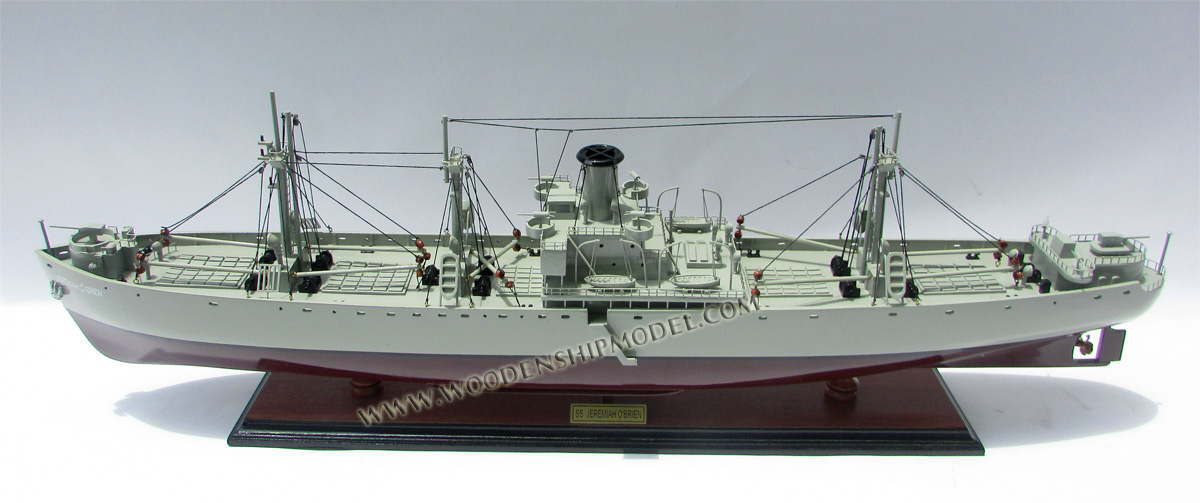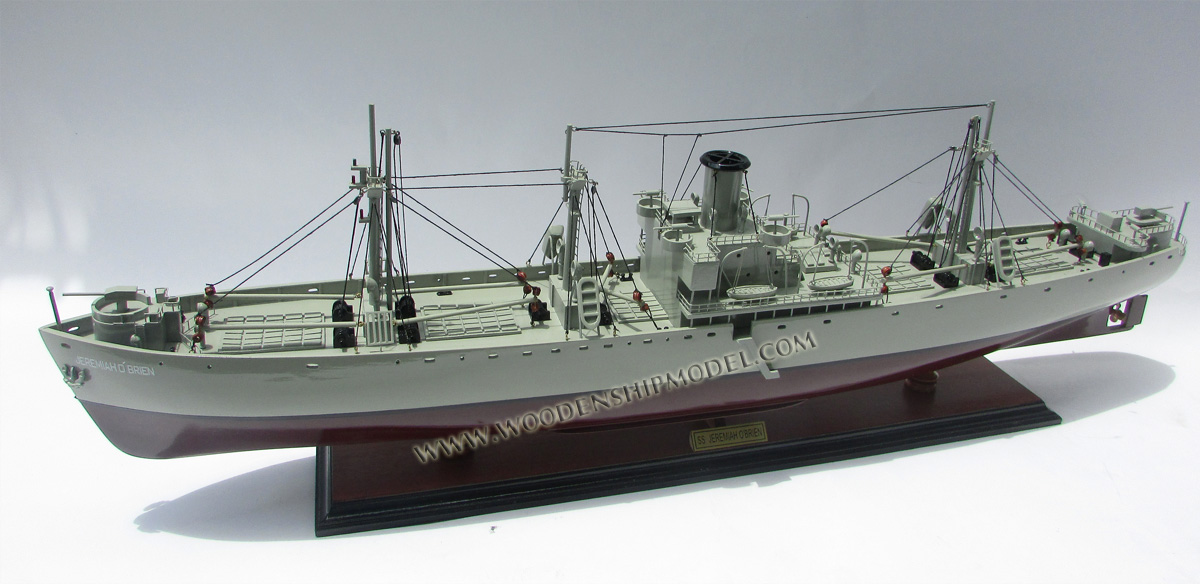|
HISTORY
Liberty
ships were cargo ships built in the United States during World War
II. Though British in conception, they were adapted by the U.S. as
they were cheap and quick to build, and came to symbolize U.S.
wartime industrial output. Based on vessels ordered by Britain to
replace ships torpedoed by German U-boats, they were purchased for
the U.S. fleet and for lend-lease provision to Britain. Eighteen
American shipyards built 2,751 Liberties between 1941 and 1945,
easily the largest number of ships produced to a single design.
The production of these vessels
mirrored, on a much larger scale, the manufacture of the Hog
Islander ship and similar standardized types during World War I. The
immense effort to build Liberty ships, the sheer number of ships
built, and the fact that some of the ships survived far longer than
the original design life of five years, make them the subject of
much study.
History and service
In 1936, the American Merchant Marine Act was passed to subsidize
the annual construction of 50 commercial merchant vessels to be used
in wartime by the United States Navy as naval auxiliaries. The
number was doubled in 1939 and again in 1940 to 200 ships a year.
Ship types included a tanker and three types of merchant vessel, all
to be powered by steam turbines. Limited industrial capacity,
especially for turbine construction, meant that relatively few of
these ships were built.
In 1940, the British government ordered 60 tramp steamships from
American yards to replace war losses and boost the merchant fleet.
These Ocean class ships were simple but fairly large (for the time)
with a single steam, 2,500 horsepower (1,864 kW) reciprocating
engine of obsolete but reliable design. Britain specified coal fired
plants because it had plenty of coal mines but no indigenous oil
fields. The predecessor designs, including the Northeast Coast, Open
Shelter Deck Steamer, were based on a simple ship originally
produced in Sunderland by J.L. Thompson & Sons (see Silver Line)
from 1879, and widely manufactured up to the SS Dorrington Court,
which was built in 1938. The order specified an 18-inch (457 mm)
increase in draught to boost displacement by 800 tons to 10,100
tons. The accommodation, bridge and main engine of these vessels
were located amidships, with a long tunnel to connect the main
engine shaft to its aft extension to the propeller. The first
Ocean-class ship, Ocean Vanguard, was launched on 16 August 1941.
The design was modified by the United States Maritime Commission to
conform to American construction practices and to make it even
quicker and cheaper to build. The U.S. version was designated
'EC2-S-C1': 'EC' for Emergency Cargo, '2' for a ship between 400 and
450 feet (140 m) long (Load Waterline Length), 'S' for steam
engines, and 'C1' for design C1. The new design replaced much
riveting, which accounted for one-third of the labour costs, with
welding, and featured oil-fired boilers. The order was given to a
conglomerate of West Coast engineering and construction companies
known as the Six Companies, headed by Henry J. Kaiser, and was also
adopted as the Merchant Marine Act design.
On 27 March 1941, the number of lend-lease ships was increased to
200 by the Defense Aid Supplemental Appropriations Act, and
increased again in April to 306, of which 117 would be Liberty
ships.
The ships were constructed of sections that were welded together.
This is similar to the technique used by Palmer's at Jarrow but
substitutes welding for riveting. Riveted ships took several months
to construct. The work force was newly trained—no one previously
built welded ships. As America entered the war, the shipbuilding
yards employed women to replace men who were enlisting in the armed
forces.
The ships initially had a poor public image because of their looks.
In a speech announcing the emergency shipbuilding program, President
Franklin D. Roosevelt had referred to the ship as "a dreadful
looking object", and Time magazine called it an "Ugly Duckling". To
try to assuage public opinion, 27 September 1941 was designated
Liberty Fleet Day, and the first 14 "Emergency" vessels were
launched that day. The first of these was SS Patrick Henry, launched
by President Franklin D. Roosevelt. In remarks at the launch
ceremony, FDR cited Patrick Henry's 1775 speech that finished "Give
me liberty or give me death". Roosevelt said that this new class of
ships would bring liberty to Europe, which gave rise to the name
Liberty ship.
Early on, each ship took about 230 days to build (Patrick Henry took
244 days), but the average eventually dropped to 42 days. The record
was set by Robert E. Peary, which was launched 4 days and 15 1/2
hours after the keel was laid, although this publicity stunt was not
repeated—and in fact much fitting-out and other work remained to be
done after the Peary was launched. The ships were made assembly-line
style, from prefabricated sections. In 1943, three new Liberty ships
were being completed every day. They were mainly named after famous
Americans, starting with the signatories of the Declaration of
Independence.
Any group which raised war bonds worth $2 million could propose a
name. Most were named for deceased people. The only living namesake
was Francis J. O'Gara, the purser of the SS Jean Nicolet, who was
thought to have been killed in a submarine attack but in fact
survived the war in a Japanese prisoner of war camp. Other
exceptions to the naming rule were the SS Stage Door Canteen, named
for the USO club in New York, and the SS U.S.O., named after the
organization itself.
Another notable Liberty ship was SS Stephen Hopkins, which sank the
German commerce raider Stier in a ship-to-ship gun battle in 1942
and became the first American ship to sink a German surface
combatant.
SS Richard Montgomery is also notable, though in a less positive
way; the wreck of the ship lies off the coast of Kent with 1,500
tons of explosives still on board, enough to match a small nuclear
weapon should they ever go off. One Liberty ship that did explode
was the SS E. A. Bryan which detonated with the power of 2,000 tons
of TNT in July 1944 as it was being loaded, killing 320 sailors and
civilians in what was called the Port Chicago disaster.
Six Liberty ships were converted at Point Clear, Alabama, by the
United States Army Air Forces into floating aircraft repair depots,
operated by the Army Transport Service, starting in April 1944. The
secret project, dubbed "Project Ivory Soap", provided mobile depot
support for B-29 Superfortress and P-51 Mustangs based on Guam, Iwo
Jima, and Okinawa beginning in December 1944. The six ARU(F)s
(Aircraft Repair Unit, Floating), however, were also fitted with
landing platforms to accommodate four R-4 helicopters, creating the
first seagoing helicopter-equipped ships, and provided medical
evacuation of combat casualties in both the Philippines and Okinawa.
The last Liberty ship constructed was the SS Albert M. Boe, launched
on 26 September 1945 and delivered on 30 October 1945. She was named
after the chief engineer of a United States Army freighter who had
stayed below decks to shut down his engines after a 13 April 1945
explosion, an act that won him a posthumous Merchant Marine
Distinguished Service MedaL.
Problems
Early Liberty ships suffered hull and deck cracks, and a few were
lost to such structural defects. During World War II, there were
nearly 1,500 instances of significant brittle fractures. Twelve
ships, including three of the 2,710 Liberties built, broke in half
without warning, including the SS John P. Gaines, which sank on 24
November 1943 with the loss of 10 lives. Suspicion fell on the
shipyards who had often used inexperienced workers and new welding
techniques to produce large numbers of ships in great haste.
Constance Tipper of Cambridge University demonstrated that the
fractures were not initiated by welding, but instead by the grade of
steel used which suffered from embrittlement. She discovered that
the ships in the North Atlantic were exposed to temperatures that
could fall below a critical point when the mechanism of failure
changed from ductile to brittle (see ductile-brittle transition
temperature, DBTT), and thus the hull could fracture relatively
easily. The predominantly welded (as opposed to riveted) hull
construction then allowed cracks to run for large distances
unimpeded. One common type of crack nucleated at the square corner
of a hatch which coincided with a welded seam, both the corner and
the weld acting as stress concentrators. Furthermore, the ships were
frequently grossly overloaded and some of the problems occurred
during or after severe storms at sea that would have placed any ship
at risk. Various reinforcements were applied to the Liberty ships to
arrest the crack problems, and the successor design, the Victory
ship, was stronger and less stiff to better deal with fatigue.
Several designs of mass-produced petroleum tankers were also
produced, the most numerous being the T2 tanker series, with about
490 built between 1942 and the end of 1945.
After the war
Many Liberty ships survived the war, and made up a large percentage
of the postwar cargo fleet. Many were bought by Greek shipowners at
very low prices. Shipping magnates like Taki Theodoracopoulos were
known to have started their fleets by buying many Liberties. The
term "Liberty-size cargo" for 10,000 tons may still be heard in the
shipping business.
In the 1960s three Liberty ships were reactivated and converted to
technical research ships (they were actually used to gather
electronic intelligence and for radar picket duties) by the United
States Navy with the hull type AGTR. SS Samuel R. Ailken became the
USS Oxford (AGTR-1), SS Robert W. Hart became the USS Georgetown
(AGTR-2), and SS J. Howland Gardner became the USS Jamestown
(AGTR-3). All of these ships were decommissioned and stricken from
the Naval Register in 1969 and 1970.
Only two operational Liberty ships survive: the SS John W. Brown
(following a long career as a school ship and many internal
modifications) and the Jeremiah O'Brien, largely in original
condition. Both museum ships, they still put out to sea regularly.
In 1994, the O'Brien steamed from San Francisco to England and
France, the only large ship that participated in the World War II
D-Day invasion to return for the 50th anniversary. In 2008, the
Arthur M. Huddell was transferred to Greece to be converted to a
floating museum dedicated to the history of the Greek merchant
marine.
Liberty ships continue to serve in a "less than whole" function many
decades after their launching. In Portland, Oregon the hulls of the
Richard Henry Dana and Jane Adams serve as the basis of floating
docks. The SS Albert M. Boe survives as the Star of Kodiak, a
landlocked cannery in Kodiak Harbor.
|













